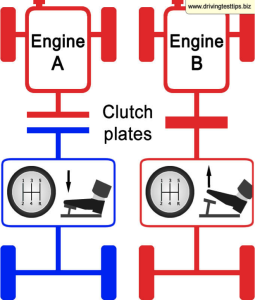Driving Lesson Romford: How Does A Clutch Work
To gain a better understanding of clutch control, you need a basic understanding of how a clutch works. A car engine, even on tick-over is constantly spinning. A clutch separates the car wheels from the engine. If the car wheels where permanently linked to the engine, it wouldn’t be possible to stop the car without the engine stalling. Without a clutch, it would also be very difficult for the car to move off from a stationary position. A clutch also enables you to change gear.
Engine A
In the diagram provided, we can see the two plates that represent the clutch. Engine A has the clutch pedal depressed to the floor, which in turn separates the clutch friction plates. When the clutch plates are separated, it disconnects the car engine from the wheels, which also prevents any power to the wheels.
One of the clutch plates is still spinning along with the engine, as the engine is constantly spinning. A gear is then selected.
Engine B
Now that the car is in-gear, the clutch pedal needs to be raised, which in turn brings the clutch plates together. When moving off from a stationary position using 1st gear, lifting the clutch pedal slowly allows the clutch plates to come together slowly. This allows the plates to slip and allow the car to move off smoothly until they are tightly pressed together, joining the broken link between the wheels and the engine.
Learning clutch control
Clutch control is a technique that allows a driver to control a cars speed. Learning clutch control is essential for passing the driving test as you may be required to demonstrate hill starts to the driving examiner, plus the driving manoeuvres require a high level of clutch control by keeping the car incredibly slow.
Learning clutch control for the first time should be done on a flat, even and quiet road. Ensure the car is setup correctly so that you can depress the clutch fully without overstretching, you are wearing your seat belt, the engine is turned on and the handbrake is OFF.
- Depress the clutch fully and select first gear.
- Provide the engine with a little extra power by very gently pressing the accelerator so that the rev counter reads around 1500 rpm.
- Ensure before your car moves that it is safe to do so and now very slowly, raise the clutch.
When the clutch plates just start to meet, this is called the clutch bite point. You will know it’s the bite point at the car will slowly start to move. The clutch bite point can occur at any point during the clutches working travel as you lift it, as all clutches are different. The bite point however will always be in the same place for that particular clutch. The key here is with plenty of practice is to remember where the bite point is.
Now that we have found the bite point, the car is slowly starting to move forward, now fully depress the clutch and gently brake to a stop. Keep repeating the process by giving the engine a little power and very slowly lifting the clutch till the car starts to move and fully depressing the clutch. By repeating this, you will gain an understanding where the bite point occurs.
Once you have got the hang of that, try it again but instead of fully depressing the clutch once the car starts to move, press the clutch just a small amount; try and think the thickness of a one pound coin. By doing this you are slightly releasing the clutch plates, disengaging the wheels and letting the car slow down. As soon as the car has slowed slightly, lift the clutch around the thickness of a one pound coin again to move the car again. Essentially what you are trying to achieve is to keep the car moving but at the slowest possible speed.
This technique is called slipping the clutch and is required to perform the driving manoeuvres on lessons and the driving test.
Moving a car off quickly
Moving a car off quickly is the same technique as above except you will need to provide significantly more gas/revs to the engine. By providing more gas, in the region of 2500 rpm, you are able to bring the clutch up faster without fear of stalling. This will enable you to move the car off much faster in situations such as busy roundabouts and pulling out of junctions.
Be a little cautious however as giving the car too much gas and releasing the clutch too fast may result in wheel spin.
Clutch control techniques
More advanced clutch control techniques will need to be mastered for holding the car steady on the clutch bite point. These techniques are important for safely moving a car off on a hill. Further information can be found in How to stop stalling a car.
Clutch control on a hill
A driving test may involve the examiner requesting you stop and move off again on a hill. This depends on the location of your driving test centreas certain parts of the UK are very flat.
If you stop on a hill, the process is similar to above, except you will require the use of the handbrake. Once stopped:
- Apply the handbrake and select first gear.
- Provide the engine with a little extra power, again around 1500 rpm on the rev counter.
- Gently raise the clutch until you reach the bite point. You will know when you have the bite point as the car may creak a little or the bonnet may rise slightly as the car tries to move forward but cannot due to the handbrake being applied.
- Provided you have the clutch bite point, the car will not roll backwards when you release the handbrake.
Get your driving lesson Romford with us now!

